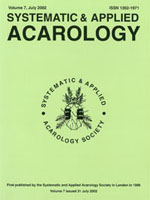The life history and life table of Tetranychus truncatus Ehara onmulberry leaflets were studied under laboratory conditions at 20, 24, 28, 31 and 35°C. Mites completed their development and produced offspring within this temperature range. The development time from egg to adult varied from 6.30 to 14.89 days. The highest immature mortality was 39.88%at 20°C followed by 30.70%at 35°C. The threshold temperatures of egg, larva, protonymph, deutonymph, and a generation were 11.38, 9.91, 10.67, 12.51 and 11.57°C whereas the day-degree requirement at each stage was 62.52, 15.38, 11.36, 11.76 and 142.83 Do, respectively. The highest number of eggs laid by fertilized females was 65.6 eggs at 24°C, followed by 64.78 eggs at 31°C. Fertilized females lived up to 28.41 days at 20°C and only 9.63 days at 35°C. Unfertilized females survived relatively longer at 24°C and produced slightly more eggs at 24 and 28°C. The net reproductive rate (Ro) was the highest (37.39) at 24°C, followed by 37.00 at 31°C. The innate capacity for increase (rm) and finite rate of increase (λ) reached maximal values (0.321 and 1.378) at 31°C, whereas minimal values (0.134 and 1.143) were at 20°C. The mean generation time was the shortest at 35°C and the shortest time for a population to double was 2.16 days at 31°C. The highest population trend index (49.49) was obtained at 24°C, followed by 48.58 at 31°C. The overall results suggested that T. truncatus could develop and reproduce within a wide range of temperatures. The range 24–31°C was the most suitable for the development, survival rate and reproduction of this mite.
How to translate text using browser tools
1 July 2003
Biology and life table of the cassava mite, Tetranychus truncatus Ehara (Acari: Tetranychidae)
Suthida Sakunwarin,
Angsumarn Chandrapatya,
Gerald T. Baker
ACCESS THE FULL ARTICLE

Systematic and Applied Acarology
Vol. 8 • No. 1
July 2003
Vol. 8 • No. 1
July 2003
BIOLOGY
development
life table
spider mite
temperature
Tetranychus truncatus




